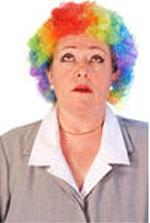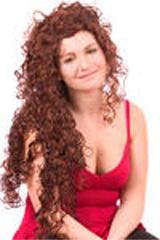
Treating of hair diseases The healthy condition of the hair depends, to a very large extent, on the intake of sufficient amounts of essential nutrients in the daily diet. Hair is made of keratin, a protein, which also makes up the nails and the outer layer of our skin. One of the primary cause of hair loss is a high amount of the male hormone, dihydrotestosterone (DHT) within the hair follicle. DHT is produced from testosterone in the prostate, various adrenal glands, and the scalp. After a period of time, an over abundance of DHT causes the hair follicle to degrade and shortens the active phase of the hair. The most important cause of hair loss is inadequate nutrition. Even a partial lack of almost any nutrient may cause hair to fall. But hair grows normally after a liberal intake of these vitamins. A high protein and and an iron rich diet is recommended for hair loss. An adequate intake of raw vegetables, fresh fruits, salads, green leafy vegetables should be included in the diet on a regular basis. Male pattern baldness that is the condition responsible for over 98% of all hair loss in men. It gets its name from the pattern of hair loss, which ultimately results in a horseshoe of hair that resides on the sides and back of the head, while the top of the head is completely bald. Some men begin MPB by losing the hair in their hairline. Others start in the crown. For women, hair loss is different. There is no set pattern for womens androgenic hair loss, which like MPB, occurs in the overwhelming majority of cases. Women can suffer from alopecia totalis and alopecia universalis just like men. Women can experience patch baldness for the same reasons as men (stress, poor nutrition, etc.), as well as due to hormonal changes from pregnancy and certain eating disorders. However, like men, the hair will generally grow back. Minoxidil (Rogaine). This over-the-counter medication is approved for the treatment of androgenetic alopecia and alopecia areata. Minoxidil is a liquid that you rub into your scalp twice daily to regrow hair and to prevent further loss. Some people experience some hair regrowth or a slower rate of hair loss or both. Minoxidil is available in a 2 percent solution and in a 5 percent solution. New hair resulting from minoxidil use may be thinner and shorter than previous hair. But there can be enough regrowth for some people to hide their bald spots and have it blend with existing hair. New hair stops growing soon after you discontinue the use of minoxidil. If you experience minimal results within six months, your doctor may recommend discontinuing use. Side effects can include irritation of the scalp.
Hair care tips Did you notice that when you shampoo your hair the amount of lather often varies? Usually, the more lather you have, the less buildup you have on your hair. It's also important to fully rinse out the shampoo to eliminate any residual detergents--they can damage the hair shaft and scalp. Excessive exposure to the sun can damage your hair by inducing oxidation of the sulfur molecules within the hair shaft, leaving the hair weak, brittle, dry and faded. People who bleach or lighten their natural hair color may also notice slight color changes in their hair when it is exposed to sun. Hair requires the same overall nutrition that the body does: plenty of fresh fruits and vegetables, grains and protein including lean meat and fish. Dietitians recommend foods high in biotin, including brown rice, bulgar, brewer's yeast, soybeans, green peas, lentils, oats, sunflower, seeds and nutritious nuts. Nutritionists advise healthy hair seekers to eat well-balanced diets that incorporate healthy proteins along with foods high in vitamins B, C, E, A and K. Hair instantly responds to the addition of protein-rich foods such as meats, eggs, cheese, seeds and nuts. Fish packs a double punch of protein combined with health building essential fatty acids and natural oils. We recommend you discuss your diet with a medical professional.
Normal hair Hair is composed of Keratin, a special protein that also produces our fingernails and toenails the nails and forms the protective outer layer of our skin. Each strand of hair consists of three concentric layers, the cuticle, the cortex and the medulla. The innermost layer of hair is called the medulla and reflects light giving hair the various color tones it has. That's why hair color looks a lot different in sunlight than it does in the shade. Whether you have straight or curly hair depends on the shape of the cortex. If the cross section of the cortex is round you will have straight hair, if the cortex is oval shaped you will have curly or wavy hair. The physical thickness and length of hair depends on what type of hair it is. Vellus hair is the fine fuzz type of hair that's often called peach fuzz. Its very fine and colorless and often almost invisible to the naked eye.

Terms interpretingAlopecia Areata
- Alopecia areata is a hair loss condition which usually affects the scalp. It can, however, sometimes affect other areas of the body.
Hair loss
- A progressive, diffuse loss of scalp hair in men that begins in the twenties or early thirties, depends on the presence of the androgenic hormone testosterone, and is caused by a combination of genetic and hormonal factors. Also called androgenetic alopecia.
Hair transplantation
- Hair transplantation is a surgical procedure used to treat baldness or hair loss (alopecia). Typically, tiny patches of scalp are removed from the back and sides of the head and implanted in the bald spots in the front and top of the head.
Protein
- Important building blocks of the body, composed of amino acids, involved in the formation of body structures and controlling the basic functions of the human body.
- Complex organic molecules made up of amino acids. Proteins are basic components of all living cells and are therefore among the principal substances that make up the body.
Ringworm
- The term "ringworm" refers to fungal infections that are on the surface of the skin. The early belief was that the infection was due to a worm, which it is not, although the name has stuck. Some of these fungi produce round spots, but many do not.
Thyroid
- A gland in the throat that produces hormones that regulate growth and metabolism.
- A large gland in the neck that functions in the endocrine system. The thyroid secretes hormones that regulate growth and metabolism.
Alopecia
- A hair loss, baldness, and epilation.
- Alopecia, also called hair loss, baldness, and epilation, is a common side effect of chemotherapy and radiation therapy.
Baldness
- A progressive, diffuse loss of scalp hair in men that begins in the twenties or early thirties, depends on the presence of the androgenic hormone testosterone, and is caused by a combination of genetic and hormonal factors. Also called androgenetic alopecia.
Biotin
Follicles
- A follicle (from the Latin folliculus) is a term to describe a small spherical group of cells containing a cavity.
Grafts
- To transplant or implant surgically into a bodily part to replace a damaged part or compensate for a defect.
Hormone
- A substance, usually a peptide or steroid, produced by one tissue and conveyed by the bloodstream to another to effect physiological activity, such as growth or metabolism.
Scalp
- The skin covering the top of the human head with its attached hair.
Stress
- Importance, significance, or emphasis placed on something.
- The relative force with which a sound or syllable is spoken.
- Accent or a mark representing such emphasis or force.
- An applied force or system of forces that tends to strain or deform a body.
- A mentally or emotionally disruptive or upsetting condition occurring in response to adverse external influences and capable of affecting physical health, usually characterized by increased heart rate, a rise in blood pressure, muscular tension, irritability, and depression.
- A state of extreme difficulty, pressure, or strain.
- A physical and psychological response that results from being exposed to a demand or pressure.
Testosterone
- A white crystalline steroid hormone, C19H28O2, produced primarily in the testes and responsible for the development and maintenance of male secondary sex characteristics. It is also produced synthetically for use in medical treatment.
|